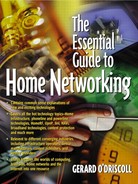SUMMARY
A wireless home network is an intriguing alternative to phone-line and powerline wiring systems. Wireless home networks provide all the functionality of wireline networks without the physical constraints of the wire itself. They generally revolve around either IR or radio transmissions within your home. Radio transmissions comprise two distinct technologies—narrowband and spread-spectrum radio. Most wireless home networking projects are based on spread-spectrum technologies. To date, the high cost and impracticality of adding new wires have inhibited the widespread adoption of home networking technologies. Wired technologies also do not allow users to roam about with portable devices. In addition, multiple, incompatible communication standards have limited acceptance of wireless networks in the home. A group called HomeRF was formed in 1998 to address these issues and develop a standard that allows the connection of A/V devices and PCs without laying any cables. Since its formation, the group has developed a specification for wireless communications in the home called SWAP-CA. The group believes that this open specification will:
Allow consumer electronic devices and PCs to talk to each other without being concerned with the existing wiring system in the home.
Enable interoperability between many different consumer electronic devices available from a large number of manufacturers.
Provide the flexibility and mobility of a wireless solution. This flexibility is important to the success of creating a compelling and complete home network solution.
Companies including Cayman Systems, Compaq, IBM, MobileStar Network, Motorola, and Proxim have announced plans to launch HomeRF-based products. The DECT standard is designed to be one of the core building blocks for the communications services of the future. Bluetooth technology is another popular solution for people who want to deploy wireless in-home networks. Bluetooth technology facilitates real-time voice and data transmission between devices on a home network. It eliminates the need for numerous, often proprietary, cable attachments for the connection of practically any kind of communication device.
Connections are instant and they are maintained even when devices are not within the line of sight. The range of each radio is approximately 10 meters, but it can be extended to around 100 meters with an optional amplifier. Today's home networking applications are driving the need for a high-performance, wireless network protocol with high usable speed (throughput) and isochronous, multimedia-capable services. ShareWave has designed the Whitecap protocol from the ground up to address consumers'needs for high performance, ease of use, reliability, and scalability. Whitecap is ideally suited to efficiently and seamlessly extending the broadband experience, delivered to the home by cable and xDSL modems and residential gateways, to any location in the home. Proxim is another established player in the emerging home networking market.
